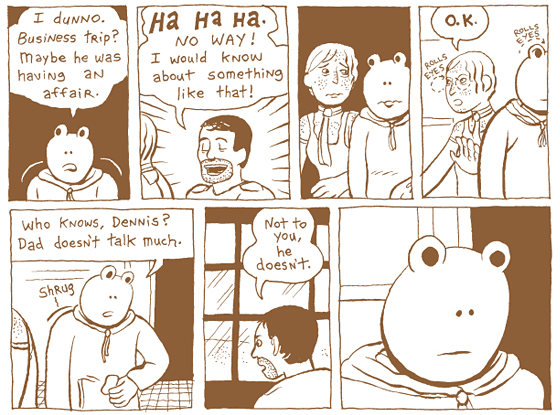
In October 2006, Gary Groth was sitting in a booth at a comics convention in Bethesda, Maryland, when he was approached by an earnest young man who pressed upon him the manuscript of a graphic novel—over 300 pages in comic-strippy black-and-white. Groth’s wariness was not assuaged by the man’s assurances that the pages represented less than half of the book he planned to write.
“It was a goddamn lot,” Groth recalls of the first third of Bottomless Belly Button, the graphic novel then-23-year-old Dash Shaw presented him. As head of Fantagraphics Books, Groth has published such luminaries as Daniel Clowes and Chris Ware; nevertheless, he’s despised by many in the comics world for the bellicose reviews in the magazine he’s run since 1976, The Comics Journal. While the comics business allows amateurs to submit their work directly to decision-makers in a manner unheard of in other media—no expo exists at which budding novelists hand manuscripts to Knopf’s Sonny Mehta (Groth’s closest analogue, if Mehta also edited a meaner version of The New York Review of Books)—it still took a striking confidence on Shaw’s part to submit his book to Groth.
The next day, back in his office in Seattle, Groth e-mailed Shaw to express his “intense interest.” By May 2007, when Shaw sent Groth the last chapters of Bottomless Belly Button, a deal was struck, and now that enormous book—720 pages of knotty family drama, emotional teen angst, lyrical passages about nature, good jokes, bad parenting, architectural schematics, rudimentary codes, and explicit sex—has become the graphic novel of the year, combining youthful exuberance, sage storytelling, and visual experimentation.
Dash Shaw is tall and thin, with a handsome but sallow face and stringy dark hair. He lives in Bed Stuy, and over lunch, he speaks so quietly he often can’t be heard, and with such care that he sometimes seems paralyzed by the need to find the mot juste. He interrupts himself over and over, asking whether I understand. (“Do you agree with that?” he inquires anxiously after making a fairly simple point.)
He wrote Bottomless Belly Button quickly: The book was scripted, drawn, and revised over two and a half years. Shaw, a School of Visual Arts grad, spent most of that time in his hometown of Richmond, Virginia, living with four roommates, none of whom knew what he was working on. “I didn’t really show it to anyone,” Shaw says.
The book tells the story of a week in the life of the Loony family, whose parents, Maggie and David, are divorcing after 40 years. The three grown Loony children have very different responses to this news. The eldest, sportswriter Dennis, childishly refuses to accept it and digs into his parents’ memories—and into the hidden spaces of the old beach house in which he grew up—trying to understand why. The middle child, Claire, is distracted by her daughter, her absent husband, and her own hang-ups. The youngest, Peter, is something of a screwup, but spends his days at the beach falling in love. (Rare among family dramas, Bottomless Belly Button reflects the reality that siblings sometimes spend entire visits—even on momentous occasions—as far away from each other as possible.)
Shaw’s design of his three main characters reflects the vast differences among them. It’s not that they don’t look like members of the same family; they don’t even look as though they’re characters in the same graphic novel. Oft-frustrated and childlike Dennis is a cartoon—“Homer Simpson with hair,” Shaw says. Realistically drawn Claire wears long gloves, a nod to her habit of keeping emotions and loved ones at arm’s length. Peter feels hopelessly left out—“My whole family looks at me like I’m a big, dumb frog,” he tells his girlfriend—and fittingly, Shaw draws Peter with the head of a frog for the entire book, except for a single panel that’s surprising and touching when it arrives. “I like characters that look very different,” Shaw says. “Matt Groening said you should be able to recognize each of your characters in profile.”
This choice—to cartoonify his characters somewhat, while telling as naturalistic a story as possible—leads to a jarring visual disconnect in scenes in which frog-headed Peter, say, receives his first blow job. Yet that disparity between the roughness of the art and the maturity of the story—not for children! the book’s spine reads, alongside Shaw-penned faces of crying tots—lends Shaw’s work an emotional jolt that’s sometimes absent from the work of other graphic novelists, even those as acclaimed as Ware and Clowes.

Shaw’s also avoided the path that young writers so often follow, for better or for worse: He’s not really writing about himself. His parents are still married, and he seems to have been drawn to the story of a disintegrating family as a genre exercise. “It was interesting to me how there are differences in family relations,” he says, mentioning that his household is known by his friends as a calm one. “When I visit a friend’s family, the levels of emotion are unpleasant. But that’s how they do it. That’s how they know that they still love each other.” Bottomless Belly Button, it seems, was created out of a desire to see what would happen if characters from a traditional family drama—“super-dysfunctional and super-dramatic”—were placed alongside characters from a more reserved family story: a narrative game, rather than a dead-serious uncovering of emotional trauma.
This willingness to write outside his own experience makes Shaw’s comics harder to write about—he doesn’t spend our interview hinting at dark secrets in his past—but much better to read. His current project, a sci-fi-inflected Web comic called BodyWorld, resembles Bottomless Belly Button not at all, and Shaw, unlike some other “alternative cartoonists,” doesn’t feel he needs to separate himself from more-commercial work. “If Marvel called and asked if I wanted to do Ghost Rider,” Shaw says excitedly, “I would be like, ‘Hell, yeah.’ ”
Read an exclusive twenty-page excerpt from Bottomless Belly Button on Vulture.